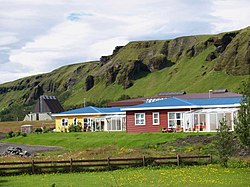Lakagigar
Lakagígar is a row of spectacular craters along twenty-five kilometres in the southern Icelandic Highlands. They formed in the eruptions at Lakí in 1784.
The system erupted violently over an eight months between June 1783 and February 1784. Lava came from the Laki fissure and the adjoining volcano Grímsvötn. It poured out an estimated 42 billion tons or 14 km3 (3.4 cu mi) of basalt lava and clouds of poisonous hydrofluoric acid and sulfur dioxide compounds. That contaminated the soil, leading to the death of over 50% of Iceland's livestock population, and the destruction of almost all crops. This led to a famine which killed about 25% of the island's human population.[1] The lava flows also destroyed 20 villages.
Lakagigar Media
Kirkjubaejarklaustur, an important church farm in South Iceland, was the home of the Rev. Jón Steingrímsson (1728–1791), who left contemporary eyewitness accounts of the effects of the eruption and its aftermath. Today, Kirkjubæjarkaustur is a small village.
References
- ↑ Gunnar Karlsson 2000. Iceland's 1100 Years, p. 181



